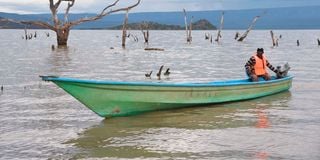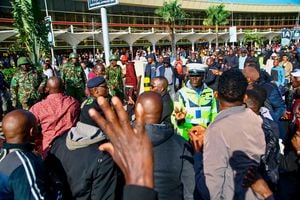Flood alarm as water levels rise in Baringo, Bogoria lakes

Wilson Lemukut, a resident of Kokwa Island in Lake Baringo, Baringo County steers his boat on the lake on April 24, 2024.
Flood alarms have been sounded as water levels in Lakes Baringo and Bogoria in the North Rift rise as a result of heavy rains in the region.
Thousands of people living around Lake Baringo and Lake Bogoria fear that the rising water levels in the lakes could wreak havoc in some of the surrounding villages.
The tourism sector has also been hit hard, with some hotels on the lakes swallowed up by the water.
Villages threatened by flooding include Leswa, Loruk, Noosukro, Kokwa Island, Kampi Samaki, Sokotei, Lorok, Kiserian, Ruggus, Loitip, Mukutani Ndogo, Ng'ambo, Sintaan, Salabani, Ilng'arua, Loboi and Longeiwan.
Soi Safari Lodge, Roberts Camp, Lake Breeze and Block Hotel on the shores of Lake Baringo are staring at heavy losses after the lake burst its banks, swallowing rooms and cottages.
At Soi Safari Lodge on the shores of Lake Baringo, more than 56 rooms, a conference hall and part of the restaurant were swallowed by the rising waters.
Lake Baringo Chief Warden Jackson Komen has confirmed that the water level of the lake has risen tremendously, swallowing some of the structures bordering the lake.
“Many structures adjacent to the lake have been swallowed by the Lake including the former Block hotels, the staff quarters, and part of Soi Safari Lodge,” he told Nation.Africa.
According to the warden, the water level around the lake has risen by an average of 15 metres in three months, and there are fears that it will continue to rise if the rains continue.
He attributed the phenomenon to siltation caused by human activities upstream.
“We fear that should the rains persist, it will swallow more structures, including roads and other social amenities. We urge locals living adjacent to the lake to move to safer areas to avert more disasters because, by the look of things, the water levels will keep increasing beyond what we experienced four years ago,” the warden warned.
He also expressed fears of human-wildlife conflict in villages bordering the hippo and crocodile-infested lake, as well as snake bites, as the water moves closer to residential areas.
Soi Safari Lodge Hotel manager Peter Chebii tells Nation.Africa that the facility has lost huge revenue after dozens of foreign tourists cancelled their bookings from July to November due to the flooding.
“We have suffered a great loss from the flooding that has swallowed most of the structures in this hotel. More than 20 tourists from the Netherlands who were expected from July to November cancelled their bookings and we are currently operating partially, as the water keeps increasing,” Mr Chebii said.
The hotel has been forced to let go of more than 15 of its staff as it struggles financially due to the impact of the flooding on its business.
It is among the tourist facilities that were flooded by the rising water level of the lake in 2020, forcing it to close for more than a year.
Lake Bogoria senior warden James Kimaru said the heavy rains have caused the lake to burst its banks, rising from an initial 34 square kilometres two months ago to 40 square kilometres at present.
According to the warden, a main gate recently constructed by the county government at the cost of Sh9 million is currently underwater. The new gate was built to replace one destroyed by floods in 2020.
“The newly constructed gate is underwater again, owing to the flooding that started a month ago. It is 10 metres inside water. The flood waters are increasing daily and Loboi shopping centre is on the verge of being swallowed should the rains continue,” said Mr Kimaru.
He said the swelling of the lake has also affected flamingo landing points as the shores are full of shrubs. The number of flamingos that go to the lake every year varies, depending on the amount of food and water level.
“The swelling of the lake has also affected the habitat of flamingos because they now have limited space to stay. Currently, you can only find the birds in specific sites, and not anywhere in the lake as usual. The shores are also covered in shrubs making it hard to spot them,” he said.
Tour guide Fox Oduor tells Nation.Africa that water levels at the lake have increased tremendously since the heavy rains started two months ago.
“If the rains persist, we may face a flooding disaster again. As per our past experiences, the lake normally increases slowly before it bursts its banks, submerging adjacent structures,” said Mr Oduor.
“Our fingers are crossed and we only pray that the calamity that struck in 2020, displacing thousands of locals, may not return because we have nowhere to seek refuge.”
Learning is yet to resume at Noosukro Primary School for the third term after some structures, including the playing field, were submerged by rising water levels in Lake Baringo.
Headteacher Jeremiah Nakure said the school management met parents last Wednesday to discuss the situation as the water levels keep rising.
“The flooding [has affected] our playing field, three pit latrines, and the teachers’ quarters built by the community. The classrooms are on the verge of being submerged as well,” he said.
The school has held talks with parents on the possible relocation of learners to an island should the situation worsen. We will be forced to teach the learners under trees as we look for temporary tents because, as we speak, the school can only be accessed by boat. The gate is also partially underwater,” Mr Nakure added.
In 2020, the school was completely submerged, forcing pupils to learn under trees.
In March 2020, water levels at lakes Baringo and Bogoria increased massively, flooding adjacent hotels, business premises, other social amenities, and homes. More than 10,000 people were left homeless.
Over the years, rising water levels in Lake Baringo have claimed 139.98 km² of riparian land, affecting approximately 3,087 households around the lake.
Lake Baringo water volumes increased from 236 km square in 2015 to approximately 278 km square, while Lake Bogoria increased from 34 km square to approximately 45 km square in a month, dealing a big blow to the tourism sector with property worth billions of shillings destroyed.
A report by the Kenyan Government and the United Nations Development Programme (UNDP) that studied rising water levels in the Rift Valley lakes in 2020 attributed the phenomenon to climate change, siltation caused by human activities, and geologic and tectonic activities.
Climate change was reported as the main reason for the rising water levels, with changes in land use practices being found to have led to increased runoff, causing larger volumes of water to flow directly and rapidly from the land surface into the lakes.
Findings of the research carried out from 2010 to 2020 established that Lake Turkana increased by 10 percent from 7,485km square to 8,265kms square, while Lake Baringo increased exponentially from 128 km square to 268 km, a rise of more than 108 percent.
Lake Bogoria on the other hand also rose by more than 25 percent, from 34 km to 43kms square while Lake Nakuru also rose from 40kms to 68kms, an increase of 70 percent respectively.
It was established that the increased inflow of fresh water into some of the lakes had created instability in the already fragile ecology of the lakes, negatively affecting the resilience and distribution of certain water species.
According to the report, Lake Baringo was one of the worst affected lakes in the Rift Valley flooding, with an estimated area of 108.57 km square. The flooding displaced several settlements bordering the lake, particularly the southern and the western parts, and caused major disturbances including destruction and loss of property, and animal and human lives.
Flooding has forced many families to relocate to higher ground every few months as the lake rises. Some families have rebuilt their homes more than five times.





